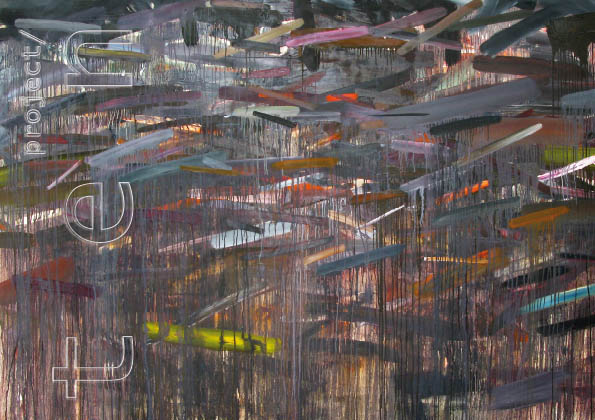Spring #3: Joao Morais walks down High St Arcade, the thoroughfare in Cardiff, to sample the latest exhibition from Project Ten.
While walking down High St Arcade, the bright Victorian shopping thoroughfare in the centre of Cardiff, it is impossible not to notice Adam Robinson’s giant abstract-expressionist painting, ‘Wet + Windy Brecon Beacons’. Placed against the back wall of Project Ten’s latest pop-up space, it is well situated to catch the eye of all passers-by in this busy part of the city centre. After the initial attention from its sheer size (the painting measures 200x300cm), the viewer is drawn to some of the more discreet emergences of neon orange and turquoise underneath the sombre hues that dominate the piece. The oil colours have been allowed to drag down the length of the canvas, and like the all-encompassing rain in the Brecon Beacons, they emote the personal experience of the artist; seeing the bright colours through Robinson’s drips, one is reminded of better times and drier days. As it is called ‘Wet + Windy Brecon Beacons’ (my italics), this implies to the viewer that the drips should perhaps not be vertical but angled – a minor complaint from a nitpicker such as myself. But ‘Wet Brecon Beacons’ as a result would not have sounded as evocative. As an eye-catcher to entice people through the doors of the gallery, the curator Cat Gardiner could not have hoped for a better piece.

Various Artists
project/ten,
High Street Arcade,
Cardiff
Spring #3, the latest group show from the project ten collective, showcases new work from the gallery’s artists and designers. As well as Adam Robinson, the gallery also welcomes Carly Llewellyn for the first time. Her flirtatious and delicate prints are depictions of intimate articles of clothing. Prints like ‘Claudia Pleat I’ are angled and close up, so it takes a second to work out what the object is, encouraging either shock or laughter in the viewer.
Up the pop-
Across the far wall of the top floor, Debbie Smyth’s ‘Stag’ is an attention-
The well-
Huw Aaron’s ink on paper pictures are to appear in a publication later this year in Eisteddfod Chair-
All in all I enjoyed the show and would recommend visiting this. Project ten always makes the most of its spaces in each new location and the shows are impressive. I look forward to the Summer exhibition to see the next evolutionary step of this collective.
http://www.project-
*Forgive me if they are not; they appeared to be hung that way, though they were numbered, in order, i, iii and iv











